|
 |
 |
|
By Jeannette Tillotson Acklen
John Warton
Following are excerpts from this book relating to John Warton and his
family.
John Wharton,
great-great-great-grandfather of Margaret Chambers-Bouton (Mrs. George Ralph Bouton),
Lebanon, Wilson County, Tenn.
REPORT FROM WAR DEPARTMENT,
WASHINGTON,
D. C.
"The records
of this office show that one John Wharton, Jr., served in the Revolutionary War as a private in Capt. Gustavus B. Wallace's Company, Third Virginia Regiment, commanded
by Col. George Weeden. The date of enlistment is not shown. His name first appears on the company payroll covering
this period from Oct 8 to Dec. 7, 1776, and is last borne on the company payroll covering the period from Jan. 1 to March 1, 1777.
"The records also show that one John Wharton, Sr.,
served in that war in the same
company and regiment. The date of enlistment is not shown. His name first appears on the company pay roll covering the period from Oct. 8 to Dec. 7, 1776, and last on
pay roll from Jan. 1 to March 1, 1777. The records further show that one John Wharton served in said war as a soldier of
Virginia Infantry, organization not further indicated. His name appears on a record under the following heading: 'A list of Virginia soldiers of the Virginia Line on Continental Establishment who have received certificates for the balance of
their full pay agreeable to an Act of Assembly passed Nov.Session, 1781, which
shows that on April 21, 1785, the sum of S. 13-D4 was received by one William Arnold? "
John Wharton,
born about 1746, married Rhoda Morris of Hanover County, Va.; settled in Albemarle County, near North Garden, Va., and reared
his family of seven sons. Late in life he and his wife lived with his son, Jesse Wharton, at Nashville, Tenn., where he died
March 3, 1816, of influenza. His wife died in 1827. They are both buried in Mt. Olivet Cemetery, Section 8, Lot 86.
CHILDREN
1.
George Wharton,
born 1765, in Virginia; died Aug. 21, 1824, in Davidson County, Tenn.; married, first, Elizabeth Farrar; married,second, Elizabeth
Harris.
2.
William H.
Wharton, born in Virginia; died in Nashville Feb. 3,1816; married Judith Harris, who died five days after her husband.
3.
John Wharton,
Jr., born in Virginia; died Feb. 7, 1845, in Bedford County, Va.; married Sally Lilbourn Logwood, daughter of Thomas Logwood.
4.
Austin Wharton,
M.D., born in Virginia; resided at Cartersville, Va., later Goochland County, Va.; died in Mississippi, 1835; married, first,
Jane Logwood, of Powatan County, Va.; married, second, Lucy Goode; married, third, Mrs. Spears, nee Bates.
5.
Jesse Wharton, born in Albemarle County, Va.; died in Nashville, Tenn., July 22, 1833; married,
first, April 20, 1804, Mary "Polly" Philips, daughter of Joseph Philips and wife, Milbrey Horn, born in Edgecomb County, N.
C., Sept 6, 1786; died in Davidson County, Tenn., April 11, 1813; children: John Overton, Joseph Philips, Rhoda Ann, Sarah
Angelina, Mary Philips. Married,
second, Elizabeth Auston Rice, of Virginia, cousin; children of second marriage: Thomas Jefferson, Jane, Ramsey, Fedelia and
two others.
6.
Samuel Leake
Wharton, born in Virginia; died in Davidson County, Tenn.; married Lucinda Farrar.
7.
Dabney Wharton,
married Anna T. Swan.
Joseph
Philips Wharton
Son of Jesse Wharton
and Mary “Polly” Philips and Great-grandfather of Margaret Chambers-Bouton (Mrs. George Ralph Bouton), Lebanon,
Tenn.
Joseph Philips Wharton, son of Jesse Wharton and his first
wife, Polly Philips, born in Davidson County, Tenn., Oct. 10, 1806; died in Wilson County, Tenn., Sept. 26, 1866; married
Sept. 21, 1830, in Nashville, Tenn., by Rev. William Hume, to Caroline C. Hewitt, daughter of Robert Hewitt and Anna Shute,
born Sept. 6, 1809; died Jan. 20, 1881.
CHILDREN
1. Mary Ann
Elizabeth Wharton, born Oct. 1, 1831; died 1924; married Frank Buchanan.
2. Robert
Hewitt Wharton, born April 1, 1885; died Oct. 29, 1917; married Feb. 16, 1864, Margaret Taylor Davis; born Nov. 29, 1843;
died Feb. 16, 1916.
3. Joseph
Philips Wharton, Jr., born Aug. 23, 1837; died May 9, 1865; C. S. A. at Rock Island.
4. Jesse
Wharton, born Aug. 19, 1839; killed in Battle of Murfreesboro, Tenn.
5. Sarah
Caroline Wharton, born Jan. 9, 1841; died Oct. 18, 1843.
6. Matilda
Emma Wharton, born Feb. 22, 1833; married, first William W. Price; married, second, Ellis Harper.
7. Margaret
Isabella Wharton, born Aug. 7,
1845; died March 24, 1901. Mary Caroline Wharton, born Feb. 17, 1848; died Jan. 20, 1900; married Jan. 20, 1870, Joseph
Balie Peyton.
Joseph
Philips Wharton lived on his farm, three miles east of Lebanon, Tenn., where he built a water mill on Spring Creek. He
and his wife are buried in private graveyard on the place, which is now owned by his descendants.
|
|
 |
 |

The following pages came from the book "Historical and Beautiful Country Homes in and Around Nashville,
Tennessee" by May Winston Caldwell (published in 1911). Notice that Polly Philips' father, Joseph Philips, gave this
home to Polly and Jesse Wharton when they wed. The name of the house is "Hill Crest".
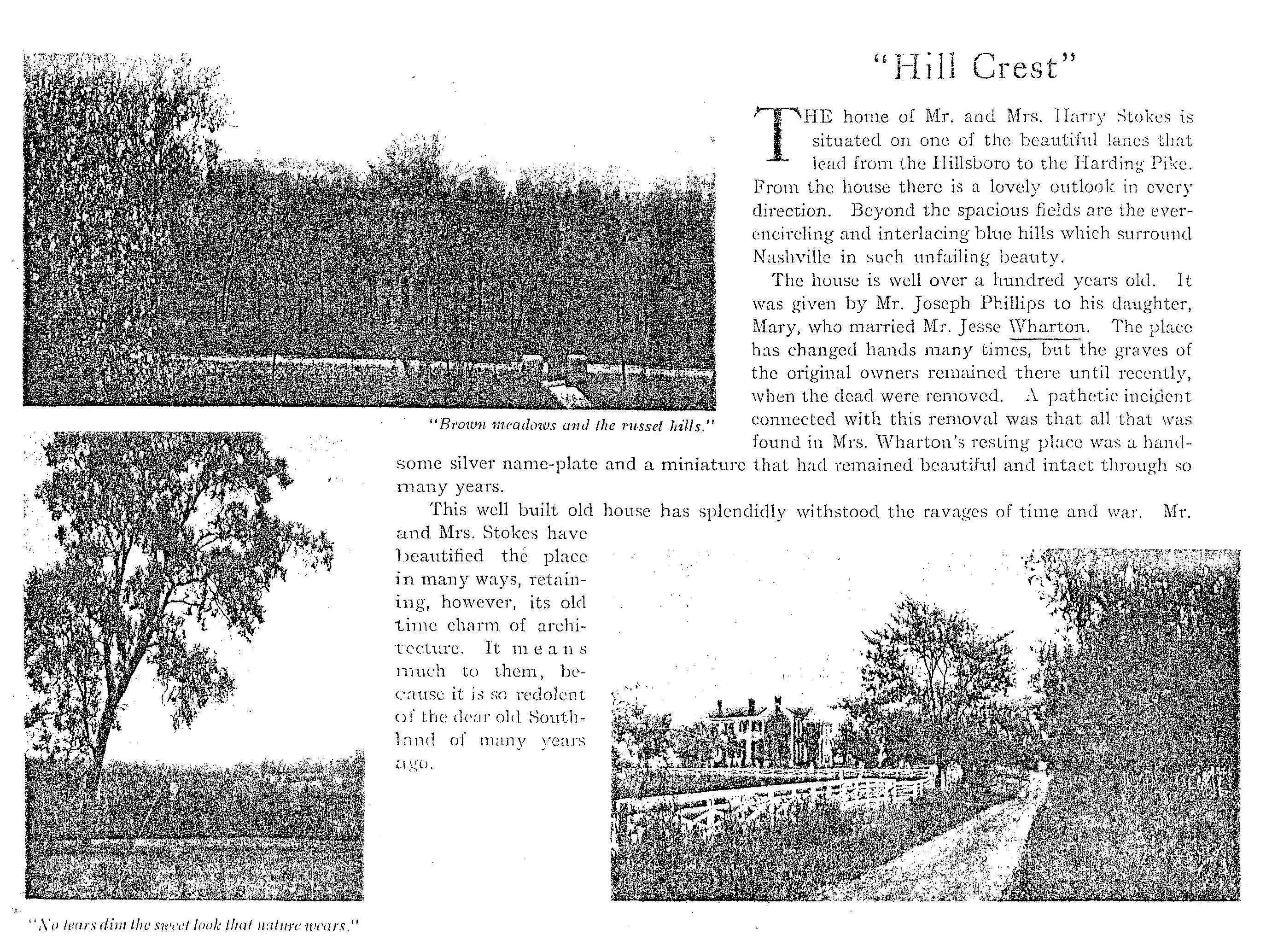
Jesse Wharton lived here until his death in 1833 and Samuel Watkins bought the house and 600 acres
in 1844. Samuel Watkins never married. He owned the property until he died on 16 October 1880.
Jesse Wharton's will appears below as filed in the Davidson County Court.
 |
 |
|
History of Davidson County, TN, by
Clayton, p 395
From 1827 to the opening
of the late war, in 1861, Mr. Samuel Watkins
was the most prominent builder and brick-maker in Nashville. In this business
he was very successful. He early selected a farm for the home of his old age,
first renting, and afterwards buying, the fine farm of nearly six hundred acres
which he has since occupied, on the Hillsboro' pike ; this purchase he made in
1844.
The
war made sad havoc in his property; his city
buildings were seized and occupied for war purposes for years, his fine park
property demolished, his farm was the seat of battle, his mansion ransacked and
robbed, fine shade-trees beyond price for their shade and beauty, fell before
the axe of war, and a loss inflicted on a peaceful non-combatant of over three
hundred thousand dollars, comprising property in negroes, buildings, cattle,
and crops.
|
|
 |
 |
The below picture of Hill Crest appears in the book "A History of Davidson County" by Clayton
on the page before the biography of Samuel Watkins.

The below picture of Hill Crest is from the book "A Past Remembered:
A Collection of Antebellum Houses in Davidson County TN" by Paul Clements and is the same house as the "Hill
Crest" house above.

According to Paul Clement, it is located on the north side of Golf Club Lane
and is the second house to the west of the intersection of 23rd Avenue South and Golf Club Lane and the outbuilding in the
photo above is still standing. The address is 2306 Golf Club Lane. The below satellite view shows the
current house.
target="new">

It appears to me from the above photos that the original lane leading to this house originated
on Woodmont Blvd. just to the west of Hillsboro Pike about where 23rd Ave. S. intersects.
The map below on the left is a U.S. Geological Survey map dated
11 Jan 1904 and shows the roads in existence at that time as well as showing the existing house locations. I have identified
what I believe to be Hill Crest with an oval tinted red and identified what I believe is present day Woodmont Blvd.
Also below on the right is a map of Davidson County made
by Foster in 1871 showing the location of S. Watson's house which I have identified with an oval tinted red.

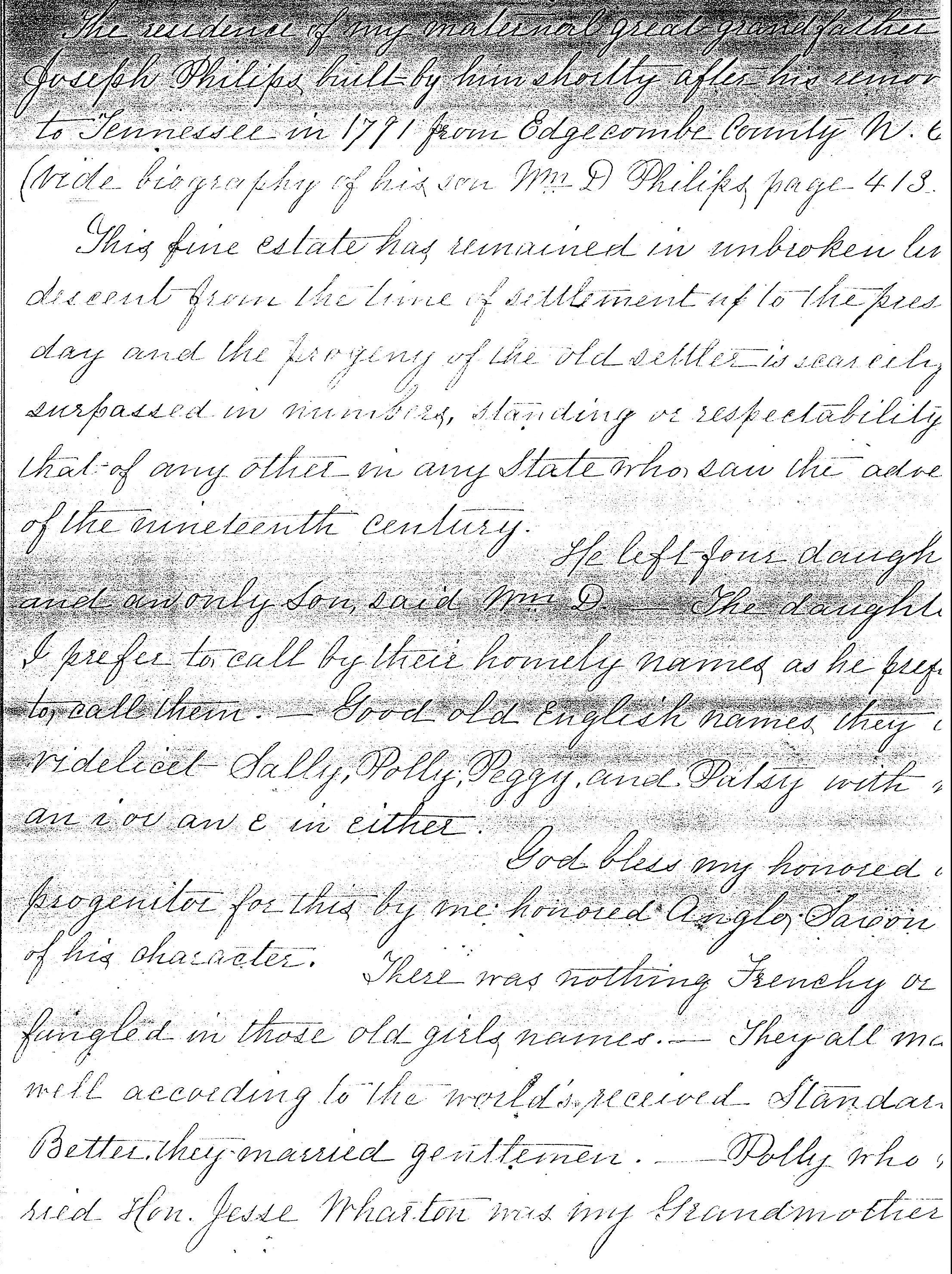

|
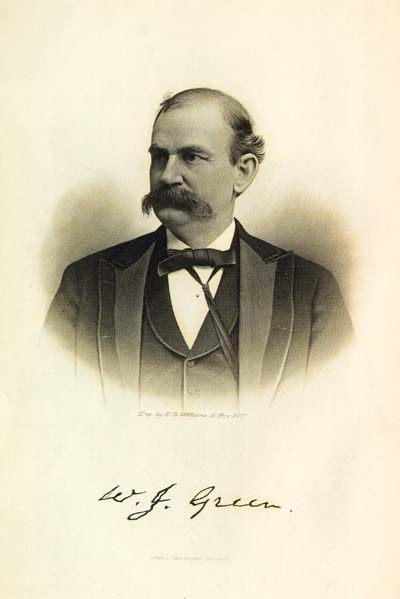
My father, Thomas J. Green, afterwards General Green of Texan Revolutionary fame, married my mother,
Sarah A. Wharton, of Nashville, Tennessee, on January 8, 1830. She was the daughter of Honorable Jesse Wharton, at one time
United States Senator in Congress. They moved to his plantation, near St. Mark's, Florida, where I was born on February 28,
1831. By death I sustained the irretrievable loss of this last dear parent on March 11, 1835, being thus deprived of
her ministering care at the early age of four years. She had met with the same great affliction when barely one year old.
She was only twenty-three, and her mother twenty-six, at the time of death. The thought that oft recurred - would I not have
been a better man had her life been spared a few years longer? Not that I have any right or cause to complain of the dear
hands that received me. On the contrary, never did motherless waif pass into gentler and more considerate keeping.
|
A few lines descriptive of this peculiarly interesting couple (my uncle, Joe Wharton, and his wife,
Caroline) will not be out of place. They had married about the time that my parents did, and had the incipiency of a young
family, which later on increased to large proportions. Two of their sons, and a son-in-law, died fighting for liberty, and
the regret of both was that they could not duplicate their tender to the Cause. They took me into their house as if I had
been one of their little fold, and for the nine or ten years succeeding accorded precisely the same. May their souls rest
in peace, and their reward be commensurate to their unpretentious good works. Fortunately, they were well to do. A thousand
broad acres of as inviting land as Middle Tennessee contains was their abiding-place, with forty or fifty sleek, overfed,
contented negroes to cultivate them. The recollection of that home and the blessed spirit pervading it is a veritable dream
of Arcadia.
Everything used on the place was raised or made on the place, except sugar, coffee, powder and lead,
and a few woman's fixings. The men-folk dressed in homespun, and were well content to get it. With no attempt at ostentation
or display, they were nevertheless the most bountiful livers for their means, and in their simple way, that I have ever known.
Hospitality was a synonym for home, the latchstring being ever on the outside of the door. In those blessed days, there were
but few things to cause pain or occasion trouble.
|
|
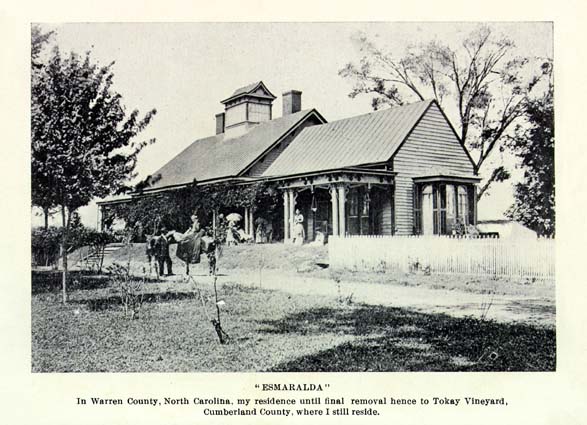
In his declining years my father, General Green, returned to his native county
(Warren NC) and settled on a plantation on Shocco Creek, known as "Esmeralda," and passed his remaining days in the cultivation
of corn and tobacco, old friendships and old-fashioned hospitality. He died 12 Dec 1863.
|
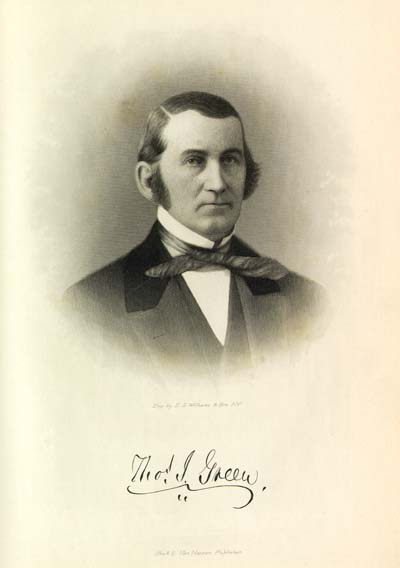
General Thomas Jefferson Green
|
 |
 |
|
Col. Jack Green, in the book excerpt above, was
married to the daughter of Jesse Wharton, Sarah Angelina Wharton.
George Blow Elliott, whose sketch appears below,
married Mabel E. Green, the daughter of Col. Wharton J. Green.
BIOGRAPHICAL
SKETCHES
of
WILMINGTON CITIZENS
by
R. H. FISHER
WILMINGTON
STAMP AND PRINTING COMPANYPublishers
WILMINGTON, NORTH CAROLINA
MCMXXIX
GEORGE BLOW ELLIOTT
GEORGE BLOW ELLIOTT, President of the Atlantic
Coast Line Railroad Company, was born at Norfolk, Va., March 22, 1873, but he has lived in Wilmington since early manhood,
when his father, the late Warren G. Elliott, came here as President of the Wilmington & Weldon Railroad. Industrially,
he easily is one of the leading citizens of the community and the state and is among the principal railroad chieftains of
America.
Mr. Elliott's early education was acquired in private schools
at Norfolk. He later attended the Norfolk Academy and graduated from the Virginia Military Institute. Class of ’92,
with the degree of Civil Engineer. In 1896, he graduated from the Law School of Harvard University with the degree of Bachelor
of Laws. It was in this latter year, also, that he actually began a railroad career that has carried him from special attorney
of the great Coast Line System to its Presidency, together with the Presidencies of three other affiliated railways; the general
counselship, advisory counselship, the chairmanship of boards or the directorship of still approximately a dozen others—the
list of which will appear later in this sketch.
The name of Elliott has been
prominent in American railroad organizations for the last half century, including such men as Warren G. Elliott, father of
George B. Elliott and first president of the consolidated Atlantic Coast Line System; John M. Elliott, general counsel of
the big Santa Fe, Rock Island and other large railroads, principally in the trans-Mississippi region; and Howard Elliott,
chairman of the board of the Northern Pacific, but whose fame rests chiefly upon his accomplishments in helping to build the
Burlington Route, now a part of the Hill group, into its present importance.
And
George B. Elliott is adding new luster to the name. Beginning in September 1892, at the age of nineteen, as assistant resident
engineer of the Chesapeake & Ohio, with headquarters at Gauley Bridge, West Virginia, he steadily climbed, by successive
promotions to Special Attorney and Local Counsel, at Richmond, Va., Atlantic Coast Line, 1896 to 1906; to Assistant General
Counsel, 1906 to 1916; General Counsel, 1916 to 1918; Vice President and General Counsel, 1918 to 1928; and, in 1928, President
of the same road, in which capacity he now is serving. For several months, after his election to the Presidency, following
the death of the late John R. Kenly, also of Wilmington, Mr. Elliott took care of the tremendous responsibilities of the system,
both as General Counsel and as President. The following list of his present positions is copied from the “Directory
of Railway Officials in America” and definitely establishes a proper basis for the boast of Wilmington citizens as contained
in the last sentence of the first paragraph of this sketch:
Elliott, George B.,
President, Atlantic Coast Line Railroad Company, Office, Wilmington, North Carolina.
President
Atlantic Land & Improvement Company, Wilmington Railway Bridge Company, the Belt Line Railway Company, Montgomery, Ala.,
and the South Carolina Pacific Railway Company.
Vice-President, Northwestern
Railroad Company of South Carolina, Winston-Salem Southbound Company, Charleston & Western Carolina Railway Company and
the North Charleston Terminal Company.
Chairman, The Executive Committee of the
Charleston & Western Carolina and of the Board and of the Executive Committee of the Columbia, Newberry & Laurens
Railroad Company.
General Counsel: The Atlantic Coast Line Company.
Advisory Counsel: Winston-Salem Southbound Railway Company and the Atlanta Birmingham & Coast Railroad
Company.
Director of: Each of the above companies and the Louisville & Nashville
Railroad Company, the Washington & Vandemere Railway Company and the Charleston Union Station Company.
That list is worth pondering. Especially so, since we, here in Wilmington, are accustomed to see Mr. Elliott
sitting in the back rows at local Democratic political meetings; appearing, with other citizens, before the city and county
commissioners to discuss hospital appropriations; working with committees on Red Cross donations; taking an active, but in
nowise, noticeably leading part in St. James Episcopal, or other, church movements; and, with equally fine and most appealing
modesty, performing such other duties as might be expected of a leading citizen in a comparatively small town—seeing
him in these varied and pretty much commonplace roles one is liable to forget (and that is exactly what he would wish) the
remarkably important niche he occupies in the industrial life of the greatest industrial nation in all the history of the
world.
The Atlantic Coast Line, when Mr. Elliott entered its service, in 1896,
as special attorney, was a good railroad, then as now, “The Standard Railroad of the South,” but it tapped only
a small area, lying along the main line through North Carolina and parts of Virginia and South Carolina, or between Richmond
and Charleston. At this date, the Atlantic Coast Line System, proper, serves six Southern states, with trackage accumulating
the total of 5,158 miles and, with its affiliated companies, the L. & N. and other lines, this total is increased to the
aggregate of 14,477.
Viewed from another angle: The Coast Line, with general
offices in Wilmington and employing nearly 2,000 local people, owns and operates more than 1,000 locomotives; more than 34,000
freight cars; more than 800 passenger cars; plus a miscellaneous rolling stock of closs to 2,000 cars. With the L. & N.
and other affiliated roads, these totals may be tripled and the approximate figures of the whole obtained. The Santa Fe, running
from Chicago into the Greater Southwest and thence to the Pacific Coast, has a mileage of only 8,966, and the Rock Island
System but slightly more. The Coast Line and its associate companies employ around 150,000 men and women, certain classes
of whom are the most skilled and highest paid of any wage earning group in the United States. The Pennsylvania and New York
Central lines, serving the most densely populated sections on the continent, each employs about 220,000.
These figures are included merely to suggest the importance of the Coast Line and to show that it is one
of the four or five largest railroad systems in the country, and to emphasize the fact that the President of the system is
a resident of Wilmington. And, as a resident, he shoulders all the responsibilities of that residence, in civic, religious,
educational and other matters. Just as Theodore Roosevelt was the most democratic of our Presidents, Mr. Elliott is one of
the most democratic and unassuming of this nation's most important captains of industry, and, correspondingly, his personal
friendship list is more numerous and genuine. As a member of the governing board of the James Walker Memorial Hospital, member
of the Men's Club of St. James, of the Cape Fear and the Cape Fear Country Clubs and other organizations with which he is
identified, he does his full share of the routine duties required to make these, or any organizations successful institutions.
Mr. Elliott is of English descent. The first of his American ancestors was Peter
Elliott, who came here from England, in 1730, three years before Wilmington was founded, and settled in Albemarle County,
Va. He later removed to Norfolk, and later to Camden County, in the Albemarle section of North Carolina. He married Tamer
Burgess, daughter of Dempsey Burgess. Wheeler's History of Carolina records that Dempsey Burgess was a delegate to the Halifax
Convention, or Provincial Congress, in April, 1776, serving with Cornelius Harnett and William Hooper from the Lower Cape
Fear. He also was lieutenant-colonel of field officers during that historic period and later served several terms as congressman
from North Carolina. Wheeler's History also states that Charles Elliott, who probably was a relative of Peter Elliott, was
one of the judges during the regime of the Colonial Governor, Arthur Dobbs, appointed by George II, of England, and whose
administration, chiefly was distinguished for the frequent rows between him and the Legislature.
Gilbert Elliott, grandfather of George B. Elliott, was born in Camden County, formed in 1777, from a part
of Pasquotank, served as clerk of the superior court, practiced law and otherwise was prominent in that section. His son was
Warren G. Elliott, late resident of Wilmington, second president of the Wilmington & Weldon Railroad, having been preceded
by Col. R. R. Bridgers of Wilmington. As president of the Wilmington & Weldon, Warren G. Elliott became first president
of consolidated roads which merged to compose the Atlantic Coast Line. A more detailed review of the Atlantic Coast Line appears
in the Industrial Section in the back of this volume, and covers the period when he was president of the system.
The mother of George B. Elliott was Margaret (Blow) Elliott, daughter of George Blow, for whom he was named.
The Blows were early settlers in America, emigrating here in the early 1600's. George Blow was a native of Norfolk, but spent
his young manhood in Texas where he assisted Gen. Sam Houston in the war for Texas Independence, 1836-37. He later returned
to Virginia and became a circuit (superior) court judge.
On April 19, 1899, Mr. Elliott married Miss Mabel E. Green, of Fayetteville, N. C. Mrs. Elliott is the daughter of
Colonel Wharton J. Green. The name of Green appears with distinguished prominence in North Carolina History. Thomas
Jefferson Green, grandfather of Mrs. Elliott, was a native of Warren County, a graduate of West Point and a Brigadier-General
with Sam Houston at San Jacinto in the Texas Revolution, 1836-37. He served in the legislatures of four states; First, in
1826, in North Carolina as a representative from Warren County; later, in the Florida legislature; next, in the Texas Congress
and, finally, in the state senate of California, during the gold rush to that state. He introduced the bill in the Texas Congress
fixing the Rio Grande as the international boundary line and this law became the basis of the boundary at the close of the
Mexican War when Texas was annexed. In California, he laid out the towns of Oroville and Vallejo. He married the daughter of Jesse Wharton, of Nashville, Tenn., who represented that state in both branches of the
Federal Congress. Col. Wharton J. Green, son of General Green and father of Mrs. Elliott, was distinguished as a Confederate
soldier, planter, and legislator. He participated in many of the important battles of the Civil War and invariably with brilliant
distinction. He served in Congress during the Eighties. The Greens are lineally descended from Sir John Hawkins, described
as “one of the immortal quartet of mariners who were the preservators of English liberty, civil, religious and political,
at the most critical juncture of English history, the other three being Howard of Effingham, Drake and Forbisher.”
Two children, both daughters, born of the marriage of Mr. and Mrs. Elliott, are
living. They are Margaret, now Mrs. John A. Hambleton, residing in New York City, and Esther E., at home.
|
|
 |
 |
|

